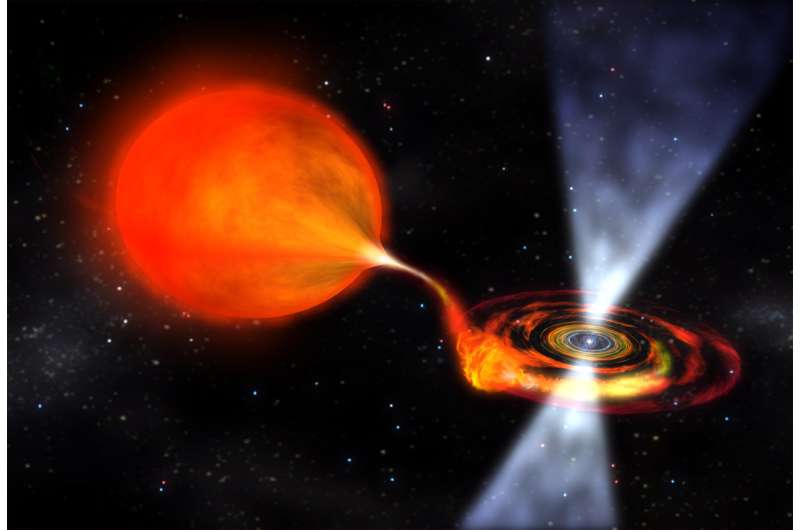Astronomers confirm extended atmosphere on accretion disk of X-ray binary

Astronomers use stellar eclipses to study the atmosphere of accretion disks around compact stars. SRON-researchers observed this method on a low-mass X-ray binary. They find a thicker atmosphere than predicted and distinguish two different gas components. The research was published in Astronomy & Astrophysics.
Almost half of observable star systems actually consist of binary star systems. The stars in these systems hold each other captive with their gravitational pull. The one with the higher gravity 'steals' material from its companion star and forms an accretion disk (see figure 1).
Currently, the exact size and geometry of accretion disks are not clear. New models and X-ray observations propose that the vertical size of the disk is bigger than older theoretical models predict. There might be an extended atmosphere above the disk. But how do you see this without the X-ray bright disk overwhelming the observation? The solution is to find a suitable X-ray binary system at such a viewing angle that the companion star eclipses the bright disk (see figure 2).
SRON-astronomers Ioanna Psaradaki, Elisa Costantini and Missagh Mehdipour, together with Maria Diaz Trigo from ESO, selected the eclipsing binary system EXO 0748-676 and studied it with the X-ray space observatory XMM-Newton. The team chose a binary of two low-mass stars for their research, as more massive stars have strong outflowing winds that are hard to distinguish from accretion flows. At times, the accreting star and its disk were completely eclipsed by the companion star, so the researchers managed to obtain a spectrum of the intriguing disk atmosphere.

The eclipse method enabled the astronomers to observe the atmosphere more directly than previous studies. They confirm that the atmosphere must be thicker than predicted and that the gas in the extended atmosphere appears in two different phases. The first gas component is hot, with a temperature close to that of the lower part of the disk. The second gas component is cooler and smaller in size, and comes from the outer part of the disk. The researchers propose that the latter component is clumpy material created by the impact of the accretion stream on the disk.
"The most likely explanation for such an extended disk atmosphere is that the accreting star photoionizes the outer parts of the disk due to strong X-ray radiation," Psaradaki says. "This phenomenon causes thermal instabilities, while the gas tries to find a stable solution. This is made possible if the disk increases its volume and hence creates an extended atmosphere, as we saw in our research."
More information: I. Psaradaki et al. Modelling the disc atmosphere of the low mass X-ray binary EXO 0748-676, Astronomy & Astrophysics (2018). DOI: 10.1051/0004-6361/201834000
Journal information: Astronomy & Astrophysics
Provided by SRON Netherlands Institute for Space Research




















